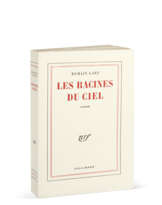ID 1317703
Lot 106 | AJAR, Émile (Romain Gary, sous le pseud. de, 1914-1980)
Estimate value
€ 10 000 – 15 000
La Vie devant soi. Paris : Mercure de France, 1975.
Exemplaire de tête, broché, non rogné, tel que paru.
Le Prix Goncourt 1956, remporté par son roman Les Racines du ciel, consacre Romain Gary, comme l'un des écrivains les plus en vue du paysage littéraire français. Ses romans suivants, parmi lesquels La Promesse de l'aube (1960) et Adieu Gary Cooper (1965) remportent un grand succès auprès du public.
En 1973, il rédige Gros-Câlin, le premier roman qu’il signe sous un nom de plume, Emile Ajar, peut-être pour ôter, le temps d’un livre d’abord, le costume de l’écrivain connu et établi, et recevoir, à nouveau, ses « premières critiques ».
« Ce fut seulement après avoir terminé Gros-Câlin que je pris la décision de publier le livre sous un pseudonyme, à l’insu de l’éditeur. Je sentais qu’il y avait incompatibilité entre la notoriété, les poids et mesures selon lesquels on jugeait mon œuvre, la gueule qu’on m’avait faite, et la nature même du livre ». L’histoire qu’il façonne à Emile Ajar est celle d’un jeune auteur, exilé au Brésil en raison de différends avec la justice – il missionne un de ses amis pour porter le manuscrit à Robert Gallimard, qui sera le seul mis dans la confidence par Gary. Il accepte de jouer le rôle du confident silencieux sans influencer le comité de lecture. Le manuscrit est refusé par la maison-mère, Robert l’envoie donc à sa cousine, Simone, au Mercure de France. Le livre est accepté et ainsi sort le premier roman d’Emile Ajar. Le mystère qui nimbe cet auteur fascine et, déjà, des hypothèses fusent pour essayer de l’identifier. Raymond Queneau fait partie des quelques noms avancés par le public et les critiques comme alter ego d’Ajar. Il n’en est rien. Membre du comité de lecture de Gallimard, Queneau aurait d’ailleurs lancé, lors d’une de leurs réunions : « je ne sais pas qui est cet Ajar, mais c’est certainement un emmerdeur ». Il flaire une mystification et ne croît pas voir ici un premier roman, mais plutôt l’œuvre d’un écrivain confirmé, qui se cache derrière un nom de plume.
Il demande à un petit cousin, Paul Pavlowitch d’en jouer le rôle, de l’incarner pour la presse et le grand public. Il faudra attendre 1981, un an après la mort de Gary, pour que Pavlowitch lui-même fasse tomber le masque.
En septembre 1975, Ajar publie un second livre – La Vie devant soi, qui remporte le prix Goncourt la même année, faisant de Gary le seul auteur à avoir reçu deux fois ce prix – ce qui est normalement impossible. Quatre jours plus tard, Paul Pavlowitch fait savoir qu’il refuse le prix Goncourt -qui lui est pourtant décerné, le comité précisant que le prix récompense un texte, et non son auteur, et qu’il est donc impossible de le refuser.
In-8 (235 x 157 mm), broché, non rogné. Édition originale. Un des 40 exemplaires sur vélin de Ruysscher, seul grand papier, celui-ci le n°8. Couverture illustrée par André François.
A pristine deluxe copy of the first edition. With La Vie devant soi (The Life Before Us), Gary became the first (and only) author to be awarded the Prix Goncourt twice, one for a book published under his real name, and the second one for La Vie devant soi, written under a pen name. Paul Pavlowitch, a realtive of Gary's, posed as Ajar for the press and the public eye. The truth was revealed soon after Gary's death ; he left a posthumous account of the whole case.
| Artist: | Romain Gary (Émile Ajar, 1914 - 1980) |
|---|---|
| Place of origin: | France |
| Auction house category: | Books |
| Artist: | Romain Gary (Émile Ajar, 1914 - 1980) |
|---|---|
| Place of origin: | France |
| Auction house category: | Books |
| Address of auction |
CHRISTIE'S 8 King Street, St. James's SW1Y 6QT London United Kingdom | |
|---|---|---|
| Preview |
| |
| Phone | +44 (0)20 7839 9060 | |
| Buyer Premium | see on Website | |
| Conditions of purchase | Conditions of purchase |











